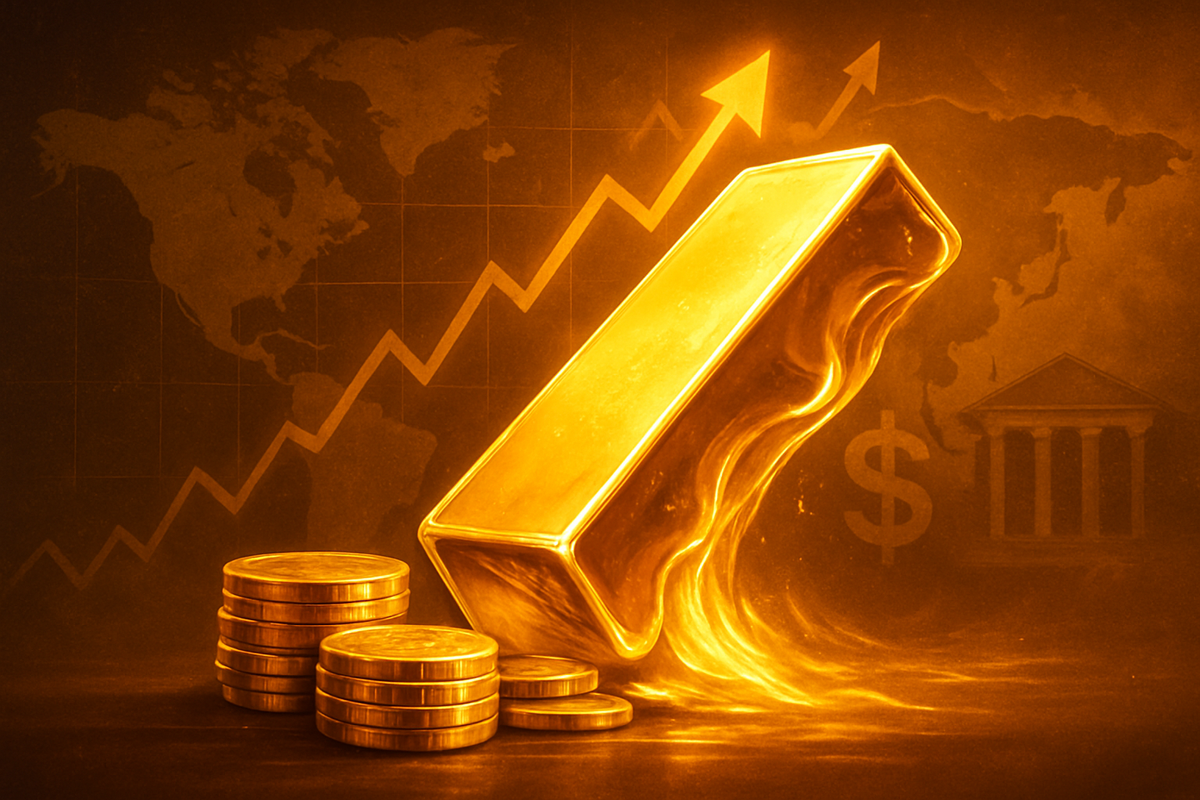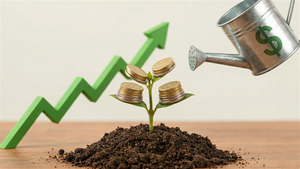
October 17, 2025 – The financial world is witnessing an extraordinary phenomenon as gold prices have surged to unprecedented levels, smashing through successive all-time highs throughout 2025. This historic rally, fueled by a potent cocktail of geopolitical instability, economic uncertainty, and shifting monetary policies, has seen the precious metal breach the formidable $4,300 per ounce mark, leaving investors and analysts alike pondering the sustainability and future trajectory of this golden ascent. The immediate implication is a significant re-evaluation of asset allocation strategies, as gold reasserts its role as the ultimate safe haven in turbulent times, potentially signaling deeper shifts in global financial architecture.
A Historic Ascent: Gold's Unprecedented Rally to New Heights
The journey to these record-breaking valuations has been swift and dramatic. Building on momentum from late 2024, gold prices first shattered the $3,000 per ounce barrier in March 2025, a psychological and historical milestone. The rally intensified, culminating in gold astonishingly breaking through the $4,000 per ounce threshold on October 8, 2025. The pace of this ascent is remarkable, with the move from $3,500/oz to $4,000/oz occurring in just 36 days. As of October 17, 2025, spot gold prices soared past $4,300 per ounce, with Comex gold futures hitting a fresh all-time high of $4,289.90 per ounce on October 16, 2025, and an overall all-time high recorded at $4,379.60 per ounce earlier in October. Domestically, in markets like India, 24K gold is retailing at an all-time high of ₹1.33 lakh per 10 grams.
This unprecedented surge—a gain of over 60% in 2025 alone and nearly 100% since its rally commenced in early 2024—is driven by a multifaceted array of factors. Persistent geopolitical tensions, including renewed trade disputes between major global powers and military flashpoints, have significantly amplified gold's appeal as a safe-haven asset. Simultaneously, expectations of a dovish shift in US monetary policy, with the Federal Reserve widely anticipated to implement multiple interest rate cuts (a 25-basis-point cut is largely priced in for October 2025), have reduced the opportunity cost of holding non-yielding gold. A weakening US dollar further enhances gold's attractiveness for international buyers.
Perhaps one of the most significant and structural drivers is the unprecedented central bank buying. Central banks, particularly in emerging markets, are aggressively diversifying their reserves away from the US dollar, a trend accelerated by concerns over asset freezes and geopolitical leverage. This strategic shift has seen central bank purchases projected to average around 710 tonnes per quarter in 2025. Complementing this institutional demand are robust Exchange Traded Fund (ETF) inflows, with gold-backed ETFs attracting over $64 billion year-to-date. Underlying these drivers are broader concerns over economic uncertainty, rising global debt levels (the US national debt surpassing $35 trillion), and the enduring allure of gold as an inflation hedge against potential US dollar debasement.
Companies Poised to Win or Lose in the Golden Rush
The meteoric rise in gold prices presents a clear delineation of winners and losers within the financial markets. Gold mining companies are undoubtedly the primary beneficiaries, as their revenue per ounce extracted dramatically increases, widening profit margins. Companies like Barrick Gold Corporation (NYSE: GOLD) and Newmont Corporation (NYSE: NEM) are seeing their stock prices appreciate significantly, driven by improved profitability and investor confidence. Their exploration and production activities become more valuable, potentially leading to increased capital expenditures and dividends. Similarly, junior mining companies with promising reserves also experience a boost in valuation, attracting new investment for development.
Furthermore, gold-backed Exchange Traded Funds (ETFs), such as the SPDR Gold Shares (NYSEARCA: GLD) and iShares Gold Trust (NYSEARCA: IAU), are witnessing substantial inflows. These instruments provide retail and institutional investors with easy exposure to gold prices without direct physical ownership, making them popular vehicles during bull runs. Companies involved in gold refining, trading, and vaulting services also stand to gain from increased market activity and demand for secure storage.
On the other hand, industries that rely on gold as a raw material, such as jewelry manufacturers and some electronics companies, may face increased input costs. While larger players might be able to absorb these costs or pass them on to consumers, smaller businesses could see their margins squeezed, potentially impacting their competitiveness and profitability. For consumers, the higher price of gold translates directly to more expensive gold products, from investment coins to luxury items. Moreover, investors heavily weighted in traditional fixed-income assets or currencies vulnerable to the same pressures driving gold's surge might find their portfolios underperforming relative to those with gold exposure.
Wider Significance: A Barometer of Global Shifts
Gold's unprecedented rally transcends mere commodity market dynamics; it serves as a potent barometer of deeper, structural shifts within the global financial and geopolitical landscape. This event fits squarely into a broader trend of de-dollarization efforts by central banks and a growing skepticism towards fiat currencies, particularly in the face of escalating national debts and unconventional monetary policies. The sustained central bank buying is not just about diversification; it reflects a strategic move to reduce reliance on any single reserve currency, particularly in a world where economic sanctions are increasingly weaponized.
The ripple effects are profound. For competitors to the US dollar, such as the Chinese Yuan or a potential future basket of currencies, gold's strength underscores the perceived fragility of the current reserve system, potentially accelerating moves towards a more multipolar financial world. Partners and allies of the US might also subtly increase their gold holdings as a hedge against future geopolitical uncertainties. From a regulatory or policy perspective, the gold surge might prompt discussions among international financial bodies about reserve management strategies and the stability of the global monetary system. It could also influence central banks' future interest rate decisions, as persistent inflation concerns (partially reflected in gold's appeal) could temper dovish inclinations.
Historically, periods of significant gold appreciation have often coincided with major global crises, high inflation, or systemic financial instability. The current rally draws parallels to the late 1970s, a period marked by high inflation and geopolitical turmoil, and the post-2008 financial crisis era. However, the current confluence of factors—sustained central bank demand, unprecedented global debt, and persistent geopolitical fragmentation—suggests a potentially more fundamental and enduring shift rather than a cyclical spike. It highlights a growing lack of confidence in traditional financial instruments and government assurances.
What Comes Next: Navigating the Golden Future
The immediate future for gold appears to be a tug-of-war between strong bullish fundamentals and technical indicators signaling an overbought market. In the short term, while the overwhelming sentiment remains positive, a potential correction or consolidation cannot be ruled out. Technical analyses, such as the Relative Strength Index (RSI) hovering around 75, suggest overbought conditions, historically preceding pullbacks. Some analysts predict a potential correction to around $3,500/oz, similar to the 2006 peak that saw a 25% drop. However, any such dip is likely to be viewed as a buying opportunity by long-term investors and central banks, given the underlying drivers.
In the long term, the outlook remains overwhelmingly bullish. Many prominent financial institutions, including J.P. Morgan Research, Bank of America, HSBC, and ANZ, project gold prices to average $3,675/oz by Q4 2025, climb toward $4,000 by mid-2026, and potentially reach $5,000 per ounce by mid-2026. This sustained growth is expected to be underpinned by ongoing US federal budget funding issues, persistent geopolitical events, and the dynamic global economic environment. Market opportunities may emerge for investors to capitalize on short-term volatility through strategic entry and exit points, while long-term holders may continue to benefit from gold's role as a store of value.
Potential strategic pivots for investors include increasing portfolio allocations to precious metals, exploring diversified gold-related investments (e.g., gold miners, royalty companies), and monitoring central bank policy shifts closely. Challenges may include managing the volatility inherent in such a rapidly appreciating asset and distinguishing between speculative bubbles and genuine fundamental strength. Potential scenarios range from a continued, albeit more gradual, ascent towards $5,000+, to a significant correction followed by a renewed rally, or even a prolonged period of consolidation at elevated levels if the driving factors stabilize.
A New Dawn for Gold: Assessing Lasting Impact
The current surge in gold prices is more than just a market event; it represents a significant re-calibration of global financial priorities and risk perceptions. The key takeaway is gold's re-establishment as a premier safe-haven asset and a credible hedge against systemic risks, both economic and geopolitical. The market moving forward is likely to see gold occupying a more central role in strategic asset allocation, not just as a fringe investment but as a core component of diversified portfolios.
The lasting impact of this rally could be a permanent upward shift in gold's price floor, reflecting a new equilibrium driven by structural demand from central banks and a persistent environment of global uncertainty. This "golden era" underscores a fundamental distrust in traditional financial stability and a flight towards tangible assets. Investors should continue to watch for several key indicators in the coming months: the trajectory of US interest rates and the dollar, the evolution of geopolitical conflicts, the pace of central bank gold accumulation, and any shifts in inflation expectations. These factors will be crucial in determining whether gold consolidates its gains or embarks on an even more ambitious journey towards uncharted price territories.
This content is intended for informational purposes only and is not financial advice





